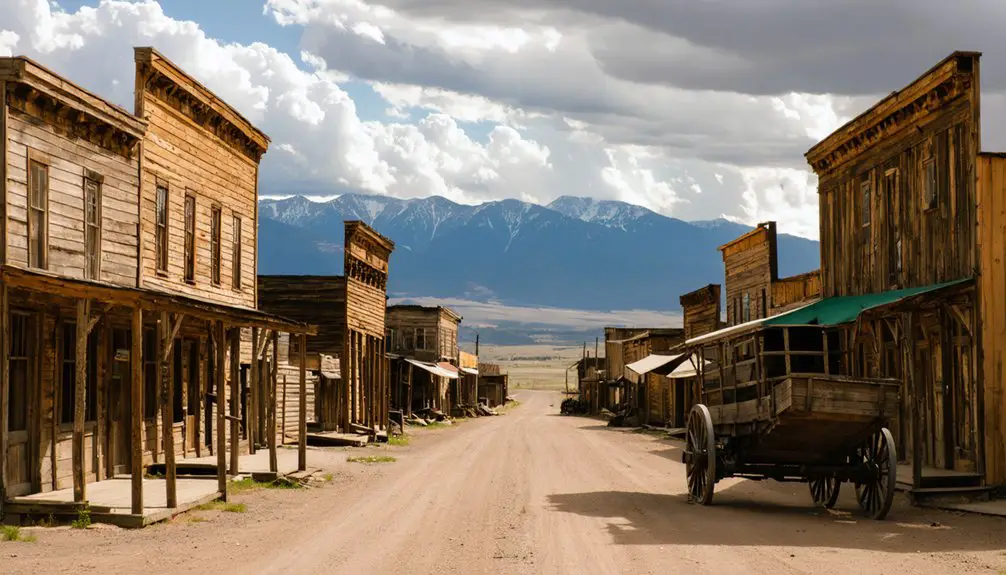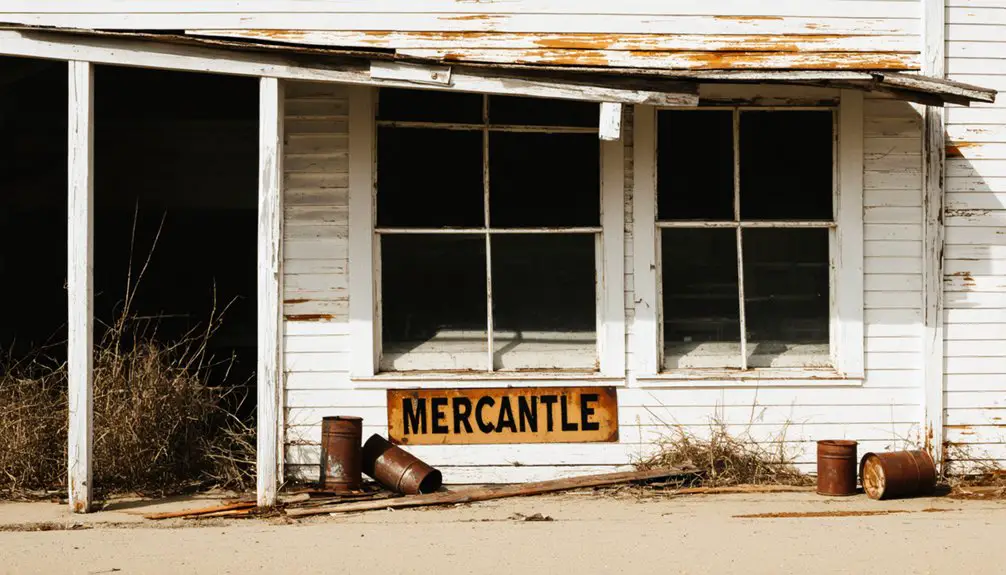You’ll find Kirkville nestled in Montana’s mountainous terrain, established in 1888 as a company town for the Bi-Metallic Mill. The mill’s massive operation processed 200 tons of silver ore daily, employing 500 workers who earned $3.50 for 12-hour shifts. Though the town thrived briefly, producing $6 million in silver during its first decade, the 1893 repeal of the Sherman Silver Purchase Act triggered its decline. Today, twin smokestacks and scattered foundations reveal a deeper story of Montana’s mining heritage.
Key Takeaways
- Founded in 1888 as a company town for the Bi-Metallic Mill, Kirkville grew to 125 residents during Montana’s silver mining boom.
- The massive Bi-Metallic Mill processed 200 tons of silver ore daily, with twin smokestacks still visible as historical landmarks today.
- Workers lived under strict company control, earning $3.50 for 12-hour shifts while depending on company-owned housing and stores.
- The town declined after the 1893 Sherman Silver Purchase Act repeal crashed silver prices, leading to eventual abandonment.
- Modern remnants include two company houses, a brick office, and assay office, though the site is now private property.
The Birth of a Mining Settlement
While the late 1880s saw numerous mining settlements spring up across Montana, Kirkville emerged in 1888 as a company town built specifically to support the Bi-Metallic Mill‘s operations near Philipsburg.
You’ll find its origins rooted in practical necessity, as settlement challenges like insufficient water at nearby Granite forced mill construction along Douglas Creek instead.
The mining motivation behind Kirkville’s establishment was clear – to house and serve the workforce needed for the ambitious Bi-Metallic Mill project. The mill’s initial construction in 1889 featured a 50-stamp capacity for processing ore.
As you explore the town’s beginnings, you’ll discover it quickly grew to accommodate about 125 residents, with essential infrastructure including worker cabins, boarding houses, and company offices. The mill building’s 360-foot length dominated the town’s landscape.
The settlement’s strategic location enabled an important two-mile tramway connection to the Blaine Shaft in Granite, forming the backbone of local silver mining operations.
Bi-Metallic Mill’s Rise to Glory
As silver mining boomed across Montana in 1889, the Bi-Metallic Mill emerged as an engineering marvel, stretching over 360 feet long and 150 feet wide along Douglas Creek.
You’ll find bi metallic innovation at every turn, from the massive 9,750-foot aerial tramway that transported 500-pound ore buckets down the mountainside to the mill’s expanding stamp capacity, which doubled from 50 to 100 stamps by 1891. The union hall ruins still stand as testament to this remarkable operation.
The mining technology showcased here was impressive – steam hoists, retort buildings, and specialized water systems for jig operations helped process up to 200 tons daily. The head tank system provided consistent water pressure essential for the mill’s sophisticated jig operations.
Advanced steam and hydraulic systems powered this engineering marvel, processing hundreds of tons of silver ore each day.
With 500 workers driving production, the mill churned out $6 million in silver over its first decade, even producing a 4,307-pound silver bullion bar that dazzled visitors at the 1893 World’s Fair in Chicago.
Life in a Company Town
As a mill worker in Kirkville, you’d experience a tightly regimented daily routine controlled by the company’s strict schedule and policies.
Similar to the Anaconda Copper Company that controlled other Montana towns, your life would intertwine completely with the company’s operations, from the house you rented to the stores where you shopped, all owned and managed by your employer.
You’d find your social activities and community interactions shaped by company-provided facilities like the baseball field and meeting hall, though these privileges came with careful oversight of your behavior and lifestyle choices. The Northern Pacific Railroad provided essential transportation services for workers and supplies through the town.
Daily Worker Routines
During Kirkville’s peak operations, around 500 workers endured grueling shifts at the mining and milling facilities, where the demanding nature of processing silver ore shaped their daily routines.
You’d have found yourself working intensely with heavy machinery, loading 500-pound ore buckets onto the tramway, or managing the scorching furnaces that never rested.
Worker schedules revolved around keeping the massive stamp mills running, processing up to 200 tons daily through the chloridization method. The Hope Mill, being Montana’s oldest mill, set the standard for intense round-the-clock operations.
Living in nearby cabins or boarding houses, you’d grab meals on-site to maximize work time. Workers paid just $2.50 per month to rent their basic accommodations.
The labor intensity was relentless – whether you were hauling fuel supplies back up the mountain or monitoring the dangerous processing equipment, your daily life centered entirely around the mill’s continuous operation.
Living Under Company Control
While Kirkville’s workers toiled in the mines and mills, their entire lives fell under the strict control of the mining company, which owned everything from the cramped worker cabins to the general store where you’d buy your supplies.
Under this corporate governance, you’d find your wages carefully balanced against inflated store prices and housing rents, keeping you financially dependent. You’d pay around $19.75 per month to rent your home during the hard times of the Great Depression.
Your social life wasn’t your own either – the company dictated which church you’d attend and what behaviors were acceptable. Workers often received their pay in company scrip, which could only be used at company-owned stores.
You’d notice the stark differences in living conditions too, with managers enjoying spacious homes while you’d be restricted to basic housing based on your job level.
If you lost your job or your spouse died, you’d likely face eviction, as the company maintained strict residency policies tied to employment.
Transportation and Infrastructure
Transportation in Kirkville centered on a sophisticated two-mile tramway system that connected the town to the Blaine Shaft in Granite. This impressive transport logistics network could move 500-pound ore buckets downhill while returning with essential fuel supplies upward, revolutionizing the town’s mining operations.
The infrastructure development included the massive Bi-Metallic Mill, spanning 360 feet long and 150 feet wide.
You’ll find evidence of extensive facilities that once supported mining operations:
- A 100-stamp mill, later expanded to handle 200 tons
- Essential buildings including boarding houses and assay offices
- Twin smokestacks that dominated the landscape until 1967
- A network of company houses and worker accommodations
Today, while most structures are gone, you can still spot remnants of this once-bustling industrial hub from nearby roads, though the mill site remains on private property.
Silver Production and Economic Impact

Three major innovations transformed Kirkville into a silver production powerhouse: a massive 360-foot Bi-Metallic Mill, an advanced chloridization process, and a sophisticated ore transport system.
You’d find 500 workers operating the facilities at peak production, processing up to 200 tons of ore daily while perfecting silver extraction methods by 1893.
The operation’s success was remarkable – the combined Granite-Bimetallic mines produced $1 million in bullion annually and even showcased a 4,307-pound silver bar at the Chicago World’s Fair.
However, the silver market’s volatility exposed Kirkville’s economic vulnerability. When the Sherman Silver Purchase Act was repealed in 1893, silver prices plummeted.
The repeal of the Sherman Act in 1893 sent silver prices crashing, revealing how dependent Kirkville’s economy was on this precious metal.
This, coupled with increasing zinc content in deeper ores and costly processing penalties, forced operations to shut down by 1894.
Daily Life and Community Spirit
Despite the harsh Montana winters and grueling twelve-hour shifts, Kirkville’s 125 residents forged a tight-knit community centered around the mill’s daily operations.
You’d find workers sharing meals at the boarding house, exchanging stories of their day’s labor, and building lasting bonds through their shared experiences. Community gatherings at the local Catholic church provided spiritual comfort and social connection on precious days off.
Your typical week in Kirkville would’ve included:
- Six days of demanding 12-hour shifts at $3.50 per day
- Communal meals with fellow workers at the boarding house
- Sunday rest and worker camaraderie at church services
- Social activities centered around company facilities
The town’s close proximity to Philipsburg offered additional opportunities for trade and entertainment, while the tramway connection to Granite kept the community’s economic lifeline flowing.
The Decline and Abandonment

When silver prices plummeted in the late 19th century, Kirkville’s fate began to unravel. Despite the Bi-Metallic and Granite Mountain Mining Operations’ merger in 1898, which yielded a million dollars in bullion annually, economic factors continued pushing the town toward collapse.
You’d have witnessed the town’s dramatic transformation as workforce reduction hit the community of 125 residents hard. The insufficient water supply and remote location only amplified Kirkville’s struggles.
Modern Remnants and Historical Legacy
Today’s visitors to Kirkville will find compelling remnants of its mining heritage scattered across the landscape. While historical preservation efforts have been minimal, several modern structures and original buildings endure, including two company houses, the brick company office, and the assay office where ore testing occurred.
Four key elements showcase Kirkville’s impressive legacy:
- The surviving twin smokestacks of the once-mighty Bi-Metallic Mill
- A modern flotation mill that continues periodic operations
- The original retort building used in ore processing
- Foundation remnants of the mill that produced a massive 4,307-pound silver bar
Though the site’s now private property limits access, you can still observe many structural remains from the adjacent road, offering glimpses into Montana’s rich mining history.
Frequently Asked Questions
What Were the Average Wages for Miners at the Bi-Metallic Mill?
You won’t find exact mining wages recorded for Bi-Metallic mill operations, but during peak times (1885-1892), miners likely earned several dollars daily, with skilled workers commanding higher rates before the 1893 crash.
Were There Any Major Accidents or Disasters During Mining Operations?
Better safe than sorry – you won’t find any major accident reports or disaster statistics from Kirkville’s mining operations. Unlike other Montana mines with documented tragedies, there’s no evidence of catastrophic incidents here.
What Happened to the Residents After the Town Was Abandoned?
You’ll find relocation stories show residents mainly moved to nearby Philipsburg or other Montana mining towns, while some stayed in Granite County for farming, causing the tight-knit community to permanently disperse.
Did Native American Tribes Have Any Significant Interactions With Kirkville?
You won’t find evidence of cultural exchanges or trade routes between Native Americans and Kirkville. Historical records show it was primarily an industrial mining town without documented tribal interactions during its operation.
Were There Any Famous Outlaws or Notable Crimes in Kirkville’s History?
Unlike the Wild West tales of Butch Cassidy’s era, you won’t find outlaw legends or notorious crime tales in Kirkville’s records. The small mining town’s history focuses on industry, not infamy.
References
- https://www.mtghosttowns.com/kirkville
- https://www.legendsofamerica.com/mt-ghosttowns/
- https://www.youtube.com/watch?v=ufRI-Y3mObk
- https://www.legendsofamerica.com/kirkville-montana/
- https://www.mtghosttowns.com
- https://westernmininghistory.com/towns/montana/granite/
- https://www.mininghistoryassociation.org/Philipsburg.htm
- https://archiveswest.orbiscascade.org/ark:80444/xv647063
- https://westernmininghistory.com/gallery/38171/historical/towns/
- https://www.hmdb.org/results.asp??Search=Place&Town=Philipsburg&State=Montana



